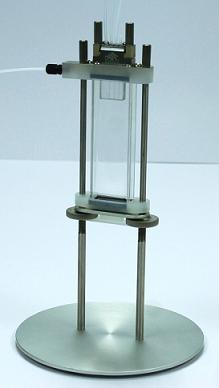Home > Press > Dolomite Launches Droplet Collection Module Allowing full flexibility in droplet analysis
 |
| Mitos Droplet Collection Module with a Droplet Junction Chip and Edge Connector, collection of sinking droplets |
Abstract:
Dolomite, a world leader in microfluidic design and manufacture, has introduced the Mitos Droplet Collection Module allowing droplets to be transferred directly from a microfluidic chip to a vessel enabling emulsions to be collected, treated and analysed.
Dolomite Launches Droplet Collection Module Allowing full flexibility in droplet analysis
Royston, UK | Posted on December 15th, 2010As part of the recently launched Droplet Collection System, the Mitos Droplet Collection Module can be used together with Dolomite's Droplet Junction Chips and Edge Connector 4-way. The droplets are ejected straight from the chip edge into bulk liquid. The microfluidic chip can be inserted into the top or bottom of the vessel allowing the collection of sinking or floating droplets without flow disruption or droplet coalescence, which can be an issue with some liquids on transfer from chip to tubing. Furthermore, the flat-sided quartz vessel enables optical analysis or UV curing of droplets to create polymeric microspheres, beads or particles for diagnostics and
biotechnology immediately after formation. Easy to access for cleaning, the Droplet Collection Module provides excellent chemical resistance as well as an overflow port to remove excess carrier liquid.
For further information on Dolomite's range of Droplet Systems and the complete portfolio of microfluidic products, including connectors/interconnects, pumps, valves and pressure/flow rate sensors and custom devices, please visit www.dolomitemicrofluidics.com.
####
About Dolomite
Established in 2005 as the world’s first Microfluidic Application Centre, Dolomite focused on working with customers to turn their concepts for microfluidic applications into reality. Today, Dolomite is the world leader in solving microfluidic problems. With offices in the UK and US and distributors throughout the rest of the world, its clients range from universities developing leading-edge analytical equipment, to manufacturers of chemical, life sciences and clinical diagnostics systems.
Dolomite is pioneering the use of microfluidic devices for small-scale fluid control and analysis, enabling manufacturers to develop more compact, cost-effective and powerful instruments. By combining specialist glass, quartz and ceramic technologies with knowledge of high performance microfluidics, Dolomite is able to provide solutions for a broad range of application areas including environmental monitoring, clinical diagnostics, food and beverage, nuclear, agriculture, petrochemical, cosmetics, pharmaceuticals and chemicals.
Furthermore Dolomite's in-house micro-fabrication facilities that include clean rooms and precision glass processing facilities allow to prototype and test all solutions rapidly which ensures a faster development cycle and reduces the time to market.
For more information, please click here
Contacts:
Sherrylee Gandhi-Mills
Marketing
The Dolomite Centre Ltd,
Unit 1, Anglian Business Park, Orchard Road, Royston, SG8 5TW, UK
Phone: +44 1763 242491
Fax: +44 1763 246125
Copyright © Dolomite
If you have a comment, please Contact us.Issuers of news releases, not 7th Wave, Inc. or Nanotechnology Now, are solely responsible for the accuracy of the content.
| Related News Press |
News and information
![]() Researchers develop molecular qubits that communicate at telecom frequencies October 3rd, 2025
Researchers develop molecular qubits that communicate at telecom frequencies October 3rd, 2025
![]() Next-generation quantum communication October 3rd, 2025
Next-generation quantum communication October 3rd, 2025
![]() "Nanoreactor" cage uses visible light for catalytic and ultra-selective cross-cycloadditions October 3rd, 2025
"Nanoreactor" cage uses visible light for catalytic and ultra-selective cross-cycloadditions October 3rd, 2025
Microfluidics/Nanofluidics
![]() Implantable device shrinks pancreatic tumors: Taming pancreatic cancer with intratumoral immunotherapy April 14th, 2023
Implantable device shrinks pancreatic tumors: Taming pancreatic cancer with intratumoral immunotherapy April 14th, 2023
![]() Researchers design new inks for 3D-printable wearable bioelectronics: Potential uses include printing electronic tattoos for medical tracking applications August 19th, 2022
Researchers design new inks for 3D-printable wearable bioelectronics: Potential uses include printing electronic tattoos for medical tracking applications August 19th, 2022
![]() Oregon State University research pushes closer to new therapy for pancreatic cancer May 6th, 2022
Oregon State University research pushes closer to new therapy for pancreatic cancer May 6th, 2022
Announcements
![]() Rice membrane extracts lithium from brines with greater speed, less waste October 3rd, 2025
Rice membrane extracts lithium from brines with greater speed, less waste October 3rd, 2025
![]() Researchers develop molecular qubits that communicate at telecom frequencies October 3rd, 2025
Researchers develop molecular qubits that communicate at telecom frequencies October 3rd, 2025
![]() Next-generation quantum communication October 3rd, 2025
Next-generation quantum communication October 3rd, 2025
![]() "Nanoreactor" cage uses visible light for catalytic and ultra-selective cross-cycloadditions October 3rd, 2025
"Nanoreactor" cage uses visible light for catalytic and ultra-selective cross-cycloadditions October 3rd, 2025
Tools
![]() Japan launches fully domestically produced quantum computer: Expo visitors to experience quantum computing firsthand August 8th, 2025
Japan launches fully domestically produced quantum computer: Expo visitors to experience quantum computing firsthand August 8th, 2025
![]() Rice researchers harness gravity to create low-cost device for rapid cell analysis February 28th, 2025
Rice researchers harness gravity to create low-cost device for rapid cell analysis February 28th, 2025
|
|
||
|
|
||
| The latest news from around the world, FREE | ||
|
|
||
|
|
||
| Premium Products | ||
|
|
||
|
Only the news you want to read!
Learn More |
||
|
|
||
|
Full-service, expert consulting
Learn More |
||
|
|
||








